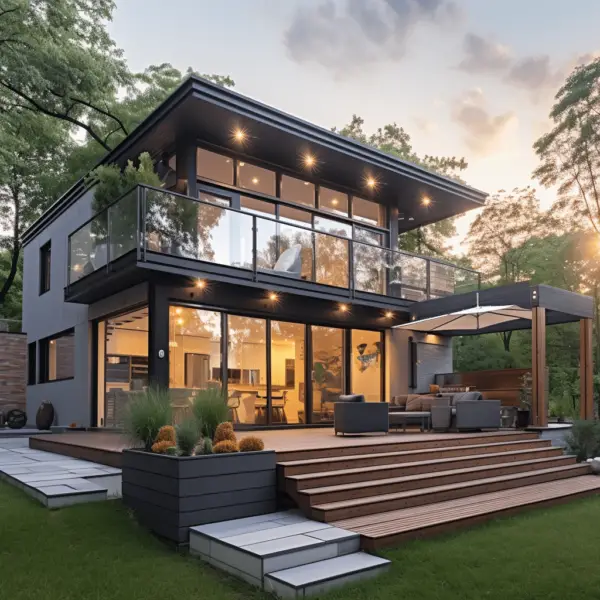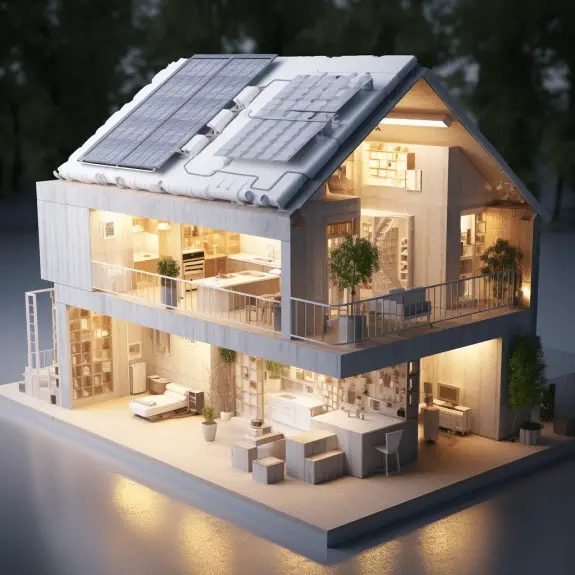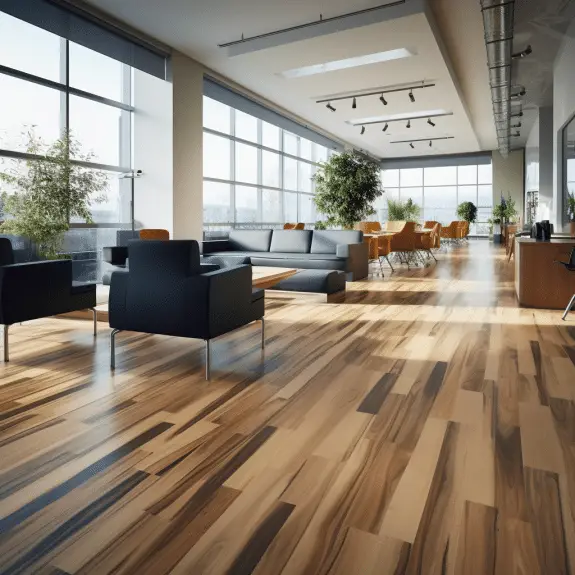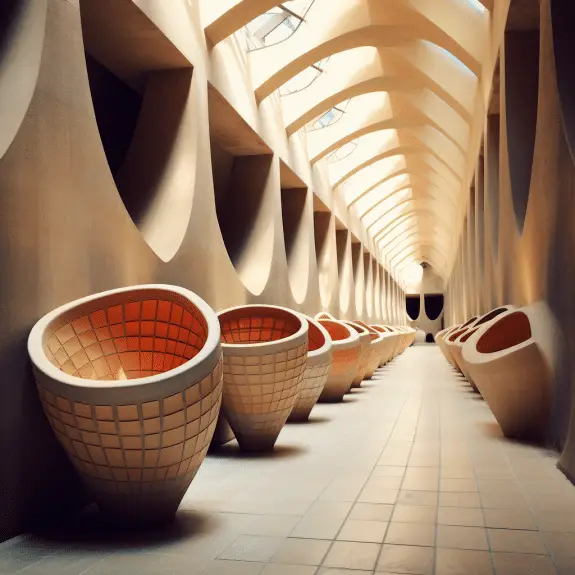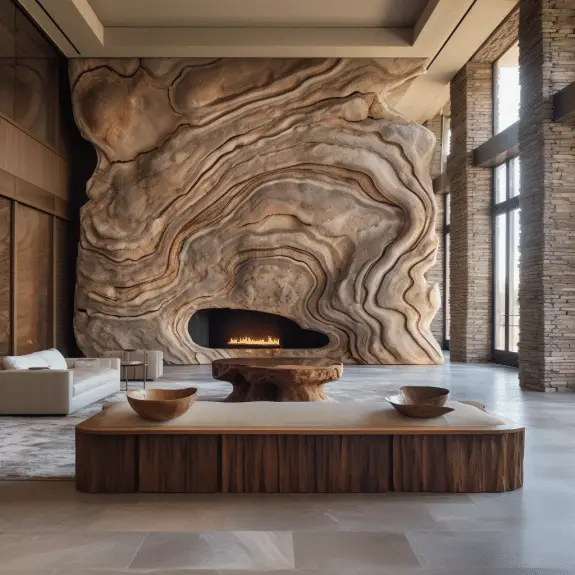Low-Maintenance Homes: A Guide to Durable Construction
By choosing the right building materials and ensuring proper installation, homeowners can significantly reduce the maintenance requirements of their properties. In this comprehensive guide, I will walk you through the process of selecting low-maintenance building materials, saving you time and money in the long run.
When it comes to construction, easy maintenance is a key consideration. Low-maintenance building materials are designed to withstand the test of time, requiring minimal upkeep while still delivering durability and longevity.
Whether you’re embarking on a new construction project or considering renovations, it’s important to choose materials that will ease the burden of maintenance over the years. Let’s explore the factors to consider and the best options available.
Key Takeaways:
- Choosing low-maintenance building materials can save time and cut costs in the long run.
- Calculate the costs involved in upfront expenses and potential future repairs.
- Consider the best low-maintenance options for roofing, gutters, siding, trim, windows and doors, decking and railing, and interior products.
- Invest in quality craftsmanship for proper installation of low-maintenance materials.
- With the right materials and care, homeowners can enjoy a low-maintenance property that stands the test of time.
Calculate the Costs
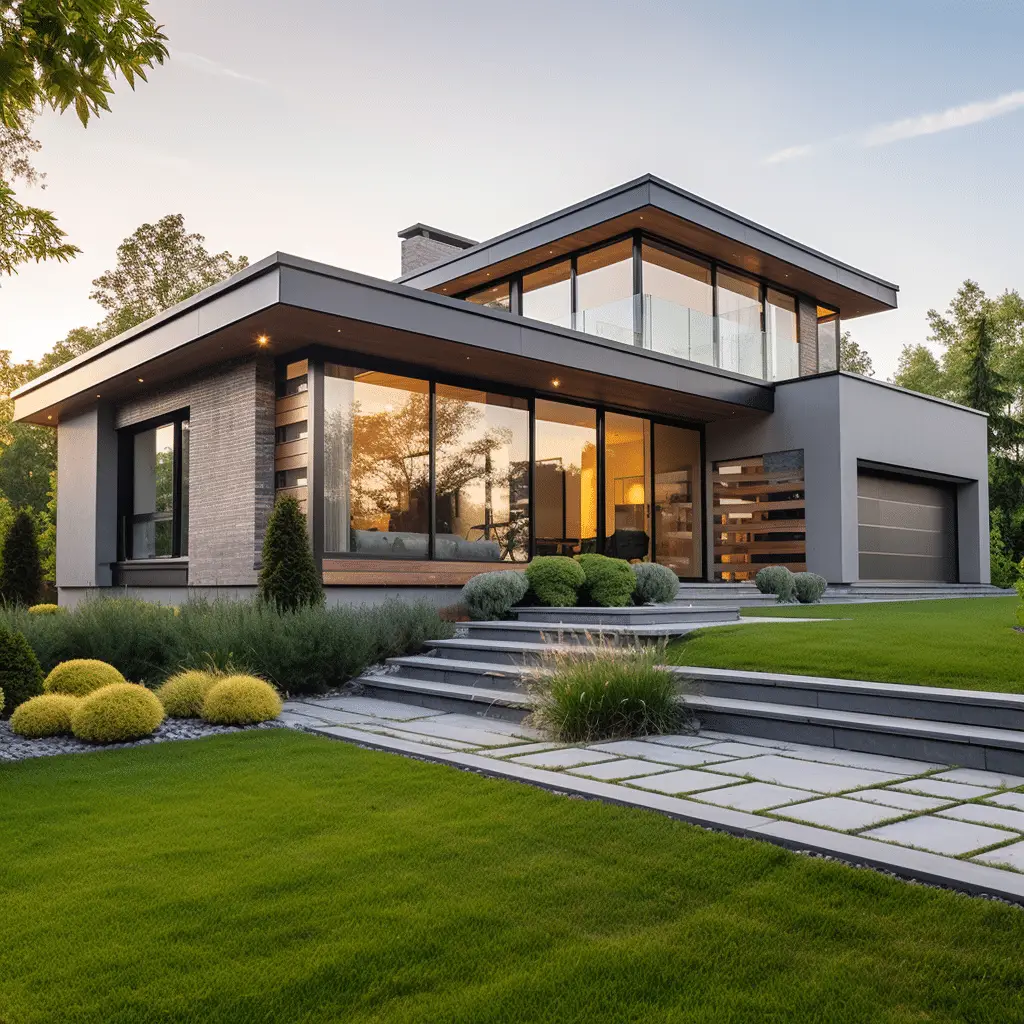
When it comes to selecting building materials for your construction project, considering the costs involved is crucial. While low-maintenance materials may have higher upfront costs, they can be cost-effective in the long run due to their durability and reduced maintenance requirements.
It’s important to remember that cheaper materials may seem like a more budget-friendly option initially, but they often come with higher maintenance costs over time. Frequent repairs and replacements can add up, resulting in a significant impact on your budget down the line.
In addition to material costs, it’s essential to factor in labor costs when calculating the overall expense of your project. Some materials may require specialized installation techniques, which can increase the labor costs. It’s important to consult with experienced contractors who have expertise in working with the specific low-maintenance materials you choose.
Cost Comparison Table
| Material | Upfront Cost | Maintenance Cost | Labor Cost |
|---|---|---|---|
| Low-Maintenance Material A | $X | $X | $X |
| Low-Maintenance Material B | $X | $X | $X |
| Traditional Material A | $X | $X | $X |
| Traditional Material B | $X | $X | $X |
This table provides a cost comparison between low-maintenance materials and traditional materials for your consideration. It illustrates the upfront cost, maintenance cost, and labor cost associated with each material. It’s important to evaluate these factors and determine the overall cost-effectiveness of your chosen materials.
By carefully calculating the costs and considering the long-term benefits of low-maintenance materials, you can make an informed decision that aligns with your budget and reduces the need for frequent maintenance and repairs.
Best Low-Maintenance Roofing Materials
When it comes to selecting roofing materials for your home, durability and low maintenance are key considerations. The roof is one of the most critical components of a house, protecting it from the elements and maintaining its structural integrity. To help you make an informed decision, here are some of the best low-maintenance roofing materials to consider:
1. Clay and Concrete Tiles
Clay and concrete tiles are known for their longevity and resistance to weathering. These materials can last for decades, requiring minimal maintenance over their lifespan. While the upfront cost may be higher compared to other options, the long-term durability and low maintenance make them a cost-effective choice.
2. Slate
Slate is a natural stone that offers exceptional durability and a distinctive appearance. It is resistant to fire, rot, and insects, making it a low-maintenance option for roofing. With proper installation and maintenance, a slate roof can last for over a century, making it a long-term investment.
3. Metal Roofing
Metal roofing, such as galvanized steel and aluminum, is known for its durability and longevity. These materials are resistant to fire, rot, and insects, and they can withstand extreme weather conditions. Metal roofs require minimal maintenance and can last for 50 years or more with proper care.
4. Cedar Shake Shingles
Cedar shake shingles offer a natural, rustic look and excellent durability. While they require periodic maintenance such as cleaning and resealing, cedar shake roofs can last for several decades when properly cared for. Regular inspections and maintenance can help prevent issues such as moss or algae growth.
5. Asphalt Shingles
Three-tab asphalt shingles and architectural asphalt shingles are popular choices for their affordability and ease of installation. While not as durable as other materials, asphalt shingles can still provide reliable protection for your home and require minimal maintenance. Regular inspections and repairs can help extend their lifespan.
By considering factors such as longevity, price range, and specific regional requirements, you can select the best low-maintenance roofing material for your home. It is essential to consult with roofing professionals to determine the most suitable option based on your budget and needs.
| Roofing Material | Longevity | Price Range |
|---|---|---|
| Clay and Concrete Tiles | 50+ years | High |
| Slate | 100+ years | High |
| Metal Roofing | 50+ years | Medium to High |
| Cedar Shake Shingles | 30+ years | Medium |
| Asphalt Shingles | 20-30 years | Low to Medium |
Low-Maintenance Gutters
When it comes to the maintenance of your home, gutters play a crucial role in preventing water damage and protecting the foundation. By selecting the right gutter materials, you can minimize the frequency of maintenance tasks and ensure the longevity of your gutters. There are several options available, each with its own advantages and considerations in terms of durability, price range, and ease of installation.
Gutter Materials
Let’s take a closer look at the different gutter materials you can choose from:
- Stainless steel: Known for its durability and resistance to corrosion, stainless steel gutters are a popular choice. They can withstand harsh weather conditions and require minimal maintenance. However, they tend to be more expensive compared to other materials.
- Copper: Copper gutters are highly durable and have an elegant appearance that can enhance the overall aesthetics of your home. They naturally develop a patina over time, which adds to their charm. While copper gutters are more expensive, they require little maintenance and can last for decades.
- Galvalume: Galvalume gutters are made from a combination of steel and aluminum, providing excellent corrosion resistance. They are a cost-effective option that requires minimal maintenance. However, they may not be as durable as stainless steel or copper gutters.
- Galvanized steel: Galvanized steel gutters are known for their strength and durability. They are coated with a layer of zinc to prevent corrosion. While galvanized steel gutters require regular maintenance to prevent rust, they can be a budget-friendly option.
- Aluminum: Aluminum gutters are lightweight, cost-effective, and resistant to rust. They are available in various colors and styles, making them a popular choice among homeowners. Aluminum gutters require periodic maintenance to remove debris and prevent clogs.
- Vinyl: Vinyl gutters are lightweight, affordable, and easy to install. They require minimal maintenance but may not be as durable as other materials. Vinyl gutters can become brittle over time, especially in extreme temperatures.
By considering factors such as longevity, price range, and the specific requirements of your home, you can choose the right gutter material that suits your needs. Proper installation and the use of gutter covers can further reduce maintenance needs and ensure the efficient functioning of your gutters.
| Gutter Material | Durability | Price Range |
|---|---|---|
| Stainless Steel | High | High |
| Copper | High | High |
| Galvalume | Medium | Medium |
| Galvanized Steel | High | Medium |
| Aluminum | Medium | Low |
| Vinyl | Low | Low |
Low-Maintenance Siding Options
When it comes to the exterior of your house, selecting low-maintenance siding materials can greatly reduce the time and cost associated with maintenance. There are various options available, each with its own lifespan, installation cost, and overall durability. By choosing the right siding materials, you can not only enhance the appearance of your home but also minimize the need for frequent repairs and replacements.
Fiber Cement:
Fiber cement siding is a popular choice for its durability and low-maintenance qualities. Made from a combination of cement, sand, and cellulose fibers, it offers excellent resistance to rot, insects, and extreme weather conditions. Fiber cement siding typically has a long lifespan of up to 50 years or more, making it a cost-effective option in the long run. While the initial installation cost may be higher compared to other materials, its low maintenance requirements make it a worthwhile investment.
Vinyl:
Vinyl siding is another low-maintenance option that is known for its affordability and versatility. It requires minimal upkeep and can withstand various weather conditions without fading or warping. Vinyl siding is available in a wide range of colors and styles, allowing homeowners to achieve their desired aesthetic. With proper installation and occasional cleaning, vinyl siding can last for many years while retaining its original appearance.
Engineered Wood:
Engineered wood siding offers the beauty of natural wood with enhanced durability and reduced maintenance needs. It is made by combining wood fibers, resins, and other materials to create a strong and stable product. Engineered wood siding is resistant to rot, insects, and moisture, making it a long-lasting and low-maintenance option. It is available in a variety of finishes and styles, providing homeowners with the opportunity to customize the look of their homes.
Choosing the right siding materials is essential for creating a low-maintenance exterior for your home. Fiber cement, vinyl, and engineered wood siding are all excellent options that offer durability, longevity, and minimal upkeep. Consider factors such as lifespan, installation cost, and overall appearance when selecting the best siding materials for your property. By investing in low-maintenance siding, you can enjoy a beautiful and hassle-free exterior for years to come.
| Siding Material | Lifespan | Installation Cost |
|---|---|---|
| Fiber Cement | Up to 50 years | Higher initial cost, but low long-term maintenance |
| Vinyl | 20-30 years | Affordable, low installation cost |
| Engineered Wood | 25-30 years | Moderate installation cost, low maintenance |
Low-Maintenance House Exterior Trim
When it comes to the exterior trim of your house, choosing low-maintenance materials can save you time and effort in the long run. There are several options available, each with its own advantages and considerations. Let’s explore some of the popular choices: wood, PVC, fiber cement, and aluminum.
Wood
Wood is a traditional and aesthetically pleasing option for exterior trim. However, it requires regular maintenance to prevent rot, warping, and insect damage. Routine painting or staining is necessary to protect the wood from the elements. While wood offers natural beauty, it may not be the most low-maintenance choice.
PVC
PVC (polyvinyl chloride) is a synthetic material that offers excellent durability and low maintenance. It is resistant to rot, moisture, and insects, making it a popular choice for exterior trim. PVC trim can be easily cleaned with soap and water and does not require painting. It retains its color and shape over time, reducing the need for frequent upkeep.
Fiber Cement
Fiber cement is a composite material made from cement, sand, and cellulose fibers. It is highly durable, resistant to rot and insects, and can withstand harsh weather conditions. Fiber cement trim requires minimal maintenance, usually limited to periodic cleaning. It can be painted to match your desired color scheme and offers a long-lasting option for your house exterior.
Aluminum
Aluminum trim is lightweight, corrosion-resistant, and easy to maintain. It does not rust or rot and can withstand exposure to the elements. Aluminum trim can be painted, offering versatility in terms of color options. Regular cleaning with soap and water is typically sufficient to keep it looking its best. Aluminum is a durable and low-maintenance choice for house exterior trim.
Choosing the right exterior trim material depends on your preferences, budget, and desired level of maintenance. While wood may require more upkeep, PVC, fiber cement, and aluminum offer more low-maintenance options. Consider the unique characteristics of each material to find the best fit for your home’s exterior.
| Exterior Trim Material | Durability | Maintenance | Appearance |
|---|---|---|---|
| Wood | Requires regular maintenance to prevent rot | Requires painting or staining | Natural and traditional look |
| PVC | Highly durable and resistant to rot and insects | Minimal maintenance, does not require painting | Clean and modern appearance |
| Fiber Cement | Highly durable and resistant to rot and insects | Minimal maintenance, may require periodic cleaning | Versatile, can be painted to match desired color |
| Aluminum | Corrosion-resistant and withstands the elements | Minimal maintenance, can be cleaned with soap and water | Sleek and lightweight appearance |
Low-Maintenance Windows and Doors
When it comes to selecting windows and doors for your home, choosing low-maintenance options can save you time and effort in the long run. Properly maintained windows and doors not only enhance the aesthetic appeal of your property but also contribute to energy efficiency and overall comfort. To help you make informed decisions, let’s explore different frame materials, energy efficiency, and maintenance considerations.
Frame Materials
The frame material you choose for your windows and doors plays a significant role in their durability and maintenance requirements. Three popular options are:
- Fiberglass: Fiberglass frames offer excellent durability, are resistant to warping and rot, and require minimal maintenance. They are also energy efficient and can withstand extreme weather conditions.
- Wood: Wood frames provide timeless beauty and excellent insulation. However, they require regular maintenance, including painting or staining and sealing to protect against rot and moisture damage.
- Composite: Composite frames combine the best qualities of various materials, such as wood and vinyl. They offer durability, low maintenance, and excellent insulation properties.
Energy Efficiency
Energy-efficient windows and doors can help reduce heating and cooling costs while providing a comfortable indoor environment. Look for features such as low-emissivity (Low-E) glass, multiple insulating layers, and weatherstripping to enhance energy efficiency. Additionally, consider options like double or triple-pane glass, which provide enhanced insulation and noise reduction.
Maintenance Considerations
While choosing low-maintenance windows and doors can minimize upkeep, some basic maintenance practices are necessary to ensure their longevity. Regular cleaning with mild soap and water, checking and repairing any seals or weatherstripping, and lubricating hinges and tracks are essential maintenance tasks to keep your windows and doors in optimal condition. Following the manufacturer’s guidelines for upkeep and scheduling professional inspections can also help identify and address any issues before they escalate.
By selecting low-maintenance windows and doors with the right frame materials and energy-efficient features, you can enjoy the benefits of a comfortable and visually appealing home while minimizing maintenance requirements.
| Frame Material | Durability | Maintenance Requirements | Energy Efficiency |
|---|---|---|---|
| Fiberglass | High | Minimal | Excellent |
| Wood | Moderate | Regular painting/staining, sealing | Good |
| Composite | High | Minimal | Excellent |
Low-Maintenance Decking and Railing Options
When it comes to building or renovating a deck, selecting low-maintenance materials can save homeowners both time and money in the long run. Durability and maintenance-free properties are essential factors to consider when choosing decking and railing materials. Here, I will discuss some popular low-maintenance options that offer excellent durability and require minimal upkeep.
Decking Materials
Decking materials play a crucial role in determining the overall lifespan and maintenance requirements of a deck. Here are some top choices for low-maintenance decking:
- Cellular PVC: Known for its durability, cellular PVC decking is resistant to stains, scratches, and fading. It requires no sealing, painting, or staining, making it virtually maintenance-free.
- Azek: Made from a composite material, Azek decking offers excellent resistance to mold, mildew, stains, and scratches. It is also easy to clean and maintain.
- Intex: Intex decking is a PVC-based material that provides exceptional strength and resistance to moisture, fading, and staining. It requires minimal maintenance, with no need for sanding, staining, or sealing.
- Ipe: Ipe decking is a durable hardwood that naturally resists rot, decay, insects, and fire. While it requires occasional maintenance, such as applying oil to maintain its rich color, it offers exceptional longevity.
Railing Materials
Choosing the right railing material is essential for a low-maintenance deck. Here are some popular options:
- Wrought Iron: Wrought iron railings are known for their timeless appeal and durability. They require minimal maintenance, usually limited to occasional cleaning and touch-ups.
- Steel Cable Systems: Steel cable railings offer a sleek and modern look while requiring minimal maintenance. They are resistant to rust and corrosion and are easy to clean.
- Aluminum: Aluminum railings are lightweight, durable, and resistant to rust and corrosion. They typically require minimal maintenance, such as occasional cleaning.
Choosing low-maintenance decking and railing materials not only reduces the time and effort spent on upkeep but also ensures a beautiful and durable outdoor space for years to come.
By selecting materials like cellular PVC, Azek, Intex, and Ipe for decking, and options such as wrought iron, steel cable systems, and aluminum for railings, homeowners can create a stunning and low-maintenance deck that requires minimal maintenance while offering long-lasting durability.
| Decking Material | Main Benefits | Maintenance Requirements |
|---|---|---|
| Cellular PVC | Durable, resistant to stains and fading | No sealing, painting, or staining required |
| Azek | Resistance to mold, mildew, stains, and scratches | Easy to clean and maintain |
| Intex | Exceptional strength and moisture resistance | No sanding, staining, or sealing required |
| Ipe | Naturally rot, decay, insect, and fire-resistant | Occasional maintenance, such as applying oil |
Note: This table provides a summary of the main benefits and maintenance requirements of low-maintenance decking materials.
Best Low-Maintenance Building Materials for Gutters
When it comes to selecting low-maintenance gutter materials, there are several options to consider. Stainless steel, copper, galvalume, galvanized steel, aluminum, and vinyl are popular choices for their durability and ease of maintenance. Each material has its strengths and cost considerations, which homeowners should assess based on their specific needs and preferences.
Comparing Durability and Installation Cost
To help you make an informed decision, let’s compare the durability and installation cost of these gutter materials:
| Gutter Material | Durability | Installation Cost |
|---|---|---|
| Stainless Steel | Highly durable and resistant to rust | Higher installation cost |
| Copper | Long-lasting and develops a beautiful patina over time | Higher installation cost |
| Galvalume | Combines the durability of galvanized steel with the corrosion resistance of aluminum | Moderate installation cost |
| Galvanized Steel | Durable but susceptible to rust over time | Moderate installation cost |
| Aluminum | Lightweight, corrosion-resistant, and available in various colors | Lower installation cost |
| Vinyl | Low-cost, lightweight, and resistant to rust and corrosion | Lower installation cost |
As shown in the table, stainless steel and copper are the most durable options, but they come with a higher installation cost. Galvalume and galvanized steel offer a good balance between durability and cost, while aluminum and vinyl are more budget-friendly choices. Consider your budget and the longevity you desire for your gutters when making your selection.
Remember, investing in high-quality gutter materials upfront can save you money in the long run by reducing maintenance needs and prolonging their lifespan.
It’s also important to note that proper installation plays a significant role in the performance and durability of your gutters. Hiring experienced professionals who specialize in gutter installation will ensure that the materials are installed correctly and maximize their effectiveness.
By selecting the best low-maintenance building materials for gutters, you can enjoy a durable and efficient gutter system that requires minimal maintenance and provides effective water management for your home.
Low-Maintenance Interior Products
When it comes to creating a low-maintenance home, it’s important to consider not only the exterior but also the interior. Choosing the right materials for flooring, cabinets, and fireplaces can significantly reduce the need for regular upkeep. Here are some low-maintenance interior products to consider:
Flooring:
Opting for maintenance-free flooring can help save time and effort. Vinyl plank flooring is a popular choice as it is durable, easy to clean, and resistant to moisture and scratches. Tile flooring, particularly porcelain or ceramic, is another low-maintenance option that offers durability and style. Composite lumber flooring, made from recycled materials, is an eco-friendly choice that requires minimal maintenance.
Cabinets:
Investing in high-quality cabinets made from durable materials can help minimize maintenance needs. Look for cabinets built with solid wood or engineered wood, as these materials are less prone to warping or damage caused by moisture. Additionally, choose cabinets with high-quality hardware to ensure smooth operation and longevity.
Fireplaces:
Maintaining a fireplace or a fuel-burning stove can be time-consuming, but there are options available that require less maintenance. Gas fireplaces provide the warmth and ambiance of a traditional fireplace without the need for regular cleaning of ashes or chimney maintenance. Pellet stoves are another low-maintenance alternative that burns compressed wood pellets, producing fewer emissions and requiring less cleaning.
By selecting flooring, cabinets, and fireplaces that are specifically designed to be low-maintenance, homeowners can enjoy a beautiful and hassle-free interior. These products not only reduce the time and effort spent on upkeep but also contribute to the overall durability and longevity of the home.
| Product | Material | Maintenance Requirements |
|---|---|---|
| Vinyl Plank Flooring | Vinyl | Easy to clean, resistant to moisture and scratches |
| Tile Flooring | Porcelain or Ceramic | Durable, easy to clean |
| Composite Lumber Flooring | Recycled materials | Eco-friendly, minimal maintenance |
| Solid Wood or Engineered Wood Cabinets | Wood | Less prone to warping or damage, high-quality hardware |
| Gas Fireplaces | Natural Gas | No cleaning of ashes, minimal maintenance |
| Pellet Stoves | Compressed Wood Pellets | Reduced emissions, less cleaning required |
The Importance of Craftsmanship
When it comes to selecting low-maintenance building materials, proper installation and craftsmanship play a crucial role in ensuring the longevity and durability of your property. No matter how high-quality the materials may be, if they are not installed correctly, they can fail and require frequent repairs and maintenance. That’s why it’s essential to work with experienced and knowledgeable contractors who have expertise in the installation techniques specific to the chosen materials.
Investing in quality craftsmanship upfront can add years to the life of your house and reduce long-term maintenance needs. A skilled craftsman will pay attention to every detail, ensuring that the materials are installed with precision and care. This includes proper sealing, correct placement, adequate support, and accurate measurements.
The Benefits of Professional Installation:
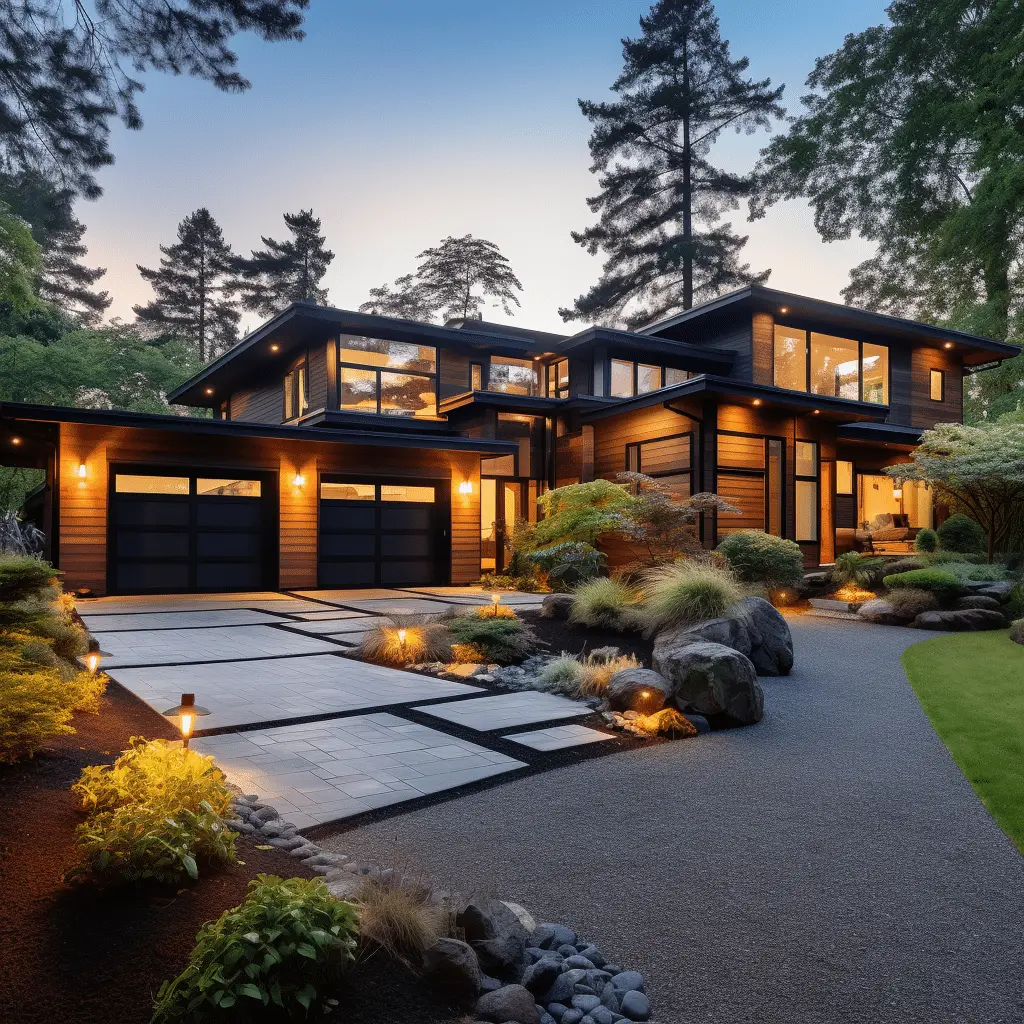
- Minimized risk of material failure
- Longer lifespan of building materials
- Reduced need for repairs and replacements
- Enhanced performance and functionality
- Compliance with industry standards and building codes
Proper installation is not only about aesthetics but also about functionality and long-term maintenance. It ensures that your low-maintenance building materials perform as intended, requiring minimal upkeep throughout their lifespan.
Additionally, professional craftsmen stay up-to-date with the latest industry practices and techniques. They have the knowledge and skills to handle any challenges that may arise during the installation process. They understand the unique requirements of different materials, whether it’s roofing, siding, gutters, windows, or decking. Their expertise allows them to identify potential issues, address them proactively, and deliver exceptional results.
So, while it’s essential to choose the right low-maintenance building materials, it’s equally important to prioritize the quality of installation. By investing in craftsmanship and hiring experienced professionals, you can enjoy a property that not only requires minimal maintenance but also stands the test of time.
| Benefits of Professional Installation | Roles of Professional Craftsman |
|---|---|
| Minimized risk of material failure | Attention to detail and precision |
| Longer lifespan of building materials | Knowledge of industry practices |
| Reduced need for repairs and replacements | Understanding of material requirements |
| Enhanced performance and functionality | Ability to handle challenges |
| Compliance with industry standards and building codes | Proactive issue identification and resolution |
Conclusion
Choosing low-maintenance building materials is an effective way to reduce maintenance needs and increase the durability of your property. By considering factors such as longevity, cost, labor, and installation expertise, homeowners can select materials that require minimal upkeep.
Proper installation and regular maintenance are essential for maximizing the lifespan of low-maintenance building materials. Adhering to the manufacturer’s instructions and working with experienced contractors can greatly enhance the longevity of your property.
With the right materials and care, homeowners can enjoy a low-maintenance property that will stand the test of time. By investing in durable and easy-to-maintain materials, you can reduce the time and cost associated with property maintenance, allowing you to focus on other aspects of homeownership and enjoying your home to the fullest.
FAQ
Are low-maintenance building materials more expensive upfront?
Yes, low-maintenance materials may have higher upfront costs, but they can be cost-effective in the long run due to their durability and reduced maintenance requirements.
How do I calculate the costs of building materials?
When calculating costs, consider both the upfront cost of the material and the potential long-term costs associated with maintenance, repairs, and replacements.
What are the best low-maintenance roofing materials?
Popular options for low-maintenance roofing materials include clay and concrete tiles, slate, galvanized steel and aluminum, copper, cedar, three-tab asphalt shingles, and architectural asphalt shingles.
What materials are recommended for low-maintenance gutters?
Stainless steel, copper, galvalume, galvanized steel, aluminum, and vinyl are common options for low-maintenance gutters. Each material has its own pros and cons in terms of durability and cost.
What are the best low-maintenance siding options?
Common low-maintenance siding materials include brick and stone, traditional stucco, fiber cement, wood (cedar, redwood), synthetic stucco (EIFS), engineered siding, vinyl, and aluminum. Factors such as lifespan, appearance, and susceptibility to insects and weathering should be considered when choosing siding materials.
What materials are recommended for low-maintenance house exterior trim?
Low-maintenance exterior trim options include wood, PVC, fiber cement, and aluminum. Each material has its own advantages and disadvantages in terms of durability, paintability, and resistance to rot and insects.
How can I choose low-maintenance windows and doors?
Consider frame materials such as fiberglass, wood, and composite, as well as energy-efficient options like double or triple-pane glass. Proper installation and regular maintenance are essential for maximizing the lifespan of windows and doors.
What are the best low-maintenance options for decking and railing?
Popular low-maintenance options for decking and railing include cellular PVC, Azek, Intex, Ipe, mahogany, wrought iron, and steel cable systems. Each material has its own advantages and maintenance requirements.
What are the best low-maintenance building materials for gutters?
Stainless steel, copper, galvalume, galvanized steel, aluminum, and vinyl are common options for low-maintenance gutters. Consider factors such as durability, corrosion resistance, ease of installation, and cost when choosing gutter materials.
What are some low-maintenance interior products?
High-quality, low-maintenance flooring options include vinyl plank, tile, and composite lumber. Cabinets should be made of durable materials with high-quality hardware. Regular maintenance is important for fireplaces and fuel-burning stoves.
How important is craftsmanship in the maintenance of low-maintenance building materials?
Proper installation and craftsmanship are crucial for maximizing the lifespan of low-maintenance building materials. It is essential to work with experienced and knowledgeable contractors who are well-versed in the installation techniques of the chosen materials.
How can low-maintenance building materials reduce maintenance needs?
By selecting low-maintenance materials and ensuring proper installation, homeowners can significantly reduce the time and cost associated with maintaining a property. These materials require less frequent repairs and replacements, saving time and money in the long run.



